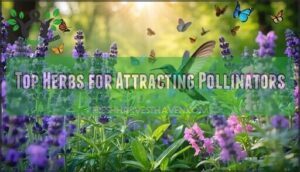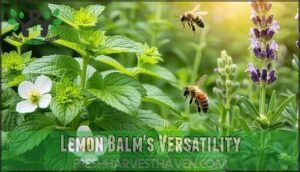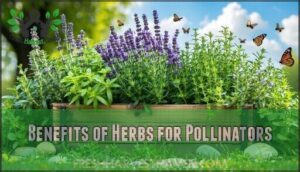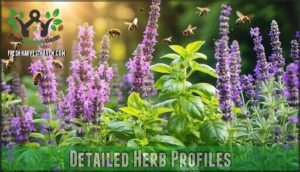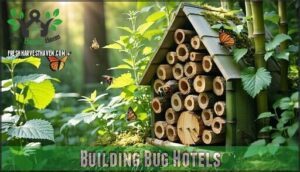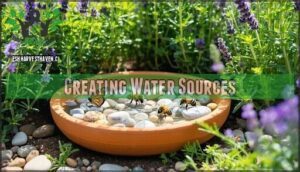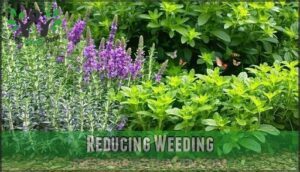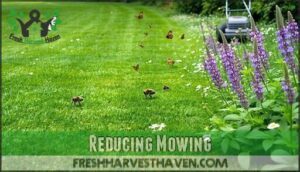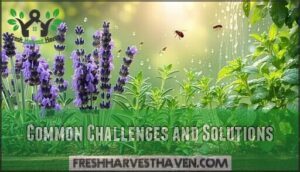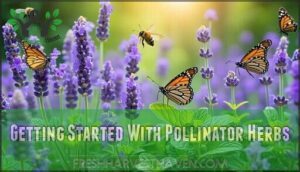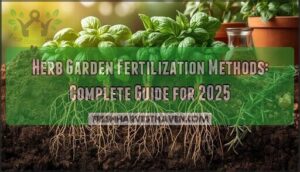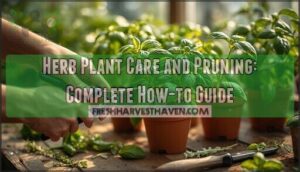This site is supported by our readers. We may earn a commission, at no cost to you, if you purchase through links.
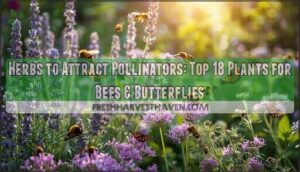
These aromatic powerhouses bloom throughout the growing season, providing essential nectar and pollen for bees, butterflies, and other beneficial insects.
Mint, sage, and chives offer dual benefits – they’re culinary workhorses and pollinator magnets. Dill, fennel, and cilantro create umbrella-like flower clusters that butterflies can’t resist.
The beauty of herb gardening lies in its simplicity: most herbs thrive in poor soil and drought conditions, making them perfect for busy gardeners. Each herb brings its own pollinator preferences and blooming timeline, creating a continuous buffet for your winged visitors throughout the season.
Table Of Contents
- Key Takeaways
- Top Herbs for Attracting Pollinators
- Lemon Balm’s Versatility
- Benefits of Herbs for Pollinators
- Importance of Pollinators
- Why Pollinator Populations Decline
- Growing Herbs for Pollinators
- Detailed Herb Profiles
- How to Help Pollinators
- Creating a Pollinator-Friendly Garden
- Common Challenges and Solutions
- Getting Started With Pollinator Herbs
- Frequently Asked Questions (FAQs)
- What are the best herbs for pollinators?
- Which herbs attract butterflies?
- What herbs attract beneficial insects?
- What plants attract pollinators the most?
- Which garden herbs attract pollinators?
- Do Flowering herbs help bees & other pollinators?
- Are flowering herbs good for pollinating insects?
- Why should you add plants that attract pollinators?
- How to make your garden a welcoming place for pollinators?
- Can a pollinator garden grow food?
- Conclusion
Key Takeaways
- Plant diverse herbs that bloom throughout the season – You’ll keep pollinators fed from spring through fall by choosing herbs like lavender, basil, thyme, and oregano that flower at different times, creating a continuous buffet for bees and butterflies.
- Choose low-maintenance herbs for maximum impact – You’ll get the biggest pollinator bang for your buck with drought-tolerant herbs like rosemary, sage, and mint that thrive with minimal care while providing consistent nectar sources.
- Let your herbs flower instead of harvesting everything – You’ll attract more pollinators by allowing some plants to bolt and bloom, as the tiny flowers on herbs like cilantro, dill, and chives are magnets for beneficial insects.
- Start small with container gardening – You don’t need acres to help pollinators – even a few pots of basil and thyme on your balcony or windowsill can provide essential food sources for bees and butterflies in urban areas.
Top Herbs for Attracting Pollinators
You’ll discover that growing herbs for pollinators creates a win-win situation where you get fresh culinary ingredients while supporting essential wildlife.
These fragrant plants naturally attract bees, butterflies, and hummingbirds with their nectar-rich blooms, making your garden both productive and ecologically valuable.
Anise Hyssop
Anise hyssop (Agastache foeniculum) stands out as one of the most bee friendly herbs you can grow.
Transform your garden into a pollinator paradise where every herb serves double duty as both culinary treasure and wildlife magnet.
Every herb flower is a tiny gas station for our hardworking pollinators.
This fragrant flowers powerhouse attracts bees, butterflies, hummingbirds, and skippers with its stunning pink-purple blooms that last from midsummer through fall.
You’ll love how this pollinator friendly herb reaches 3-5 feet tall, creating a dramatic backdrop in your herb garden.
It thrives in full sun with well-drained soil and handles drought like a champ.
Plus, it’s deer-resistant—a real win for gardeners battling hungry wildlife.
Beyond pollinator attraction, anise hyssop serves double duty.
Its licorice-scented leaves make excellent tea and have been used in herbal medicine for thousands of years to soothe sore throats and coughs.
The plant self-seeds freely, giving you sustainable blooms year after year.
This mint family member pairs beautifully with other native pollinators magnets like purple coneflower and black-eyed Susan, creating a buzzing ecosystem that’ll make your garden the neighborhood’s pollinator attraction hotspot.
Basil
While anise hyssop brings long-lasting blooms, basil offers year-round kitchen convenience with pollinator attraction.
These basil varieties like African blue and Thai basil create a pollinator friendly herb garden that’s both functional and beautiful.
Basil care requires well-drained soil and full sun. Let flower spikes develop—they’re magnets for bees and beneficial wasps.
Basil harvesting becomes more rewarding when you witness the buzzing activity around those tiny blooms.
Basil benefits extend beyond basil recipes and pesto. The flowers attract pollinators while deterring harmful pests naturally.
Plant alongside tomatoes for companion planting success, creating a thriving ecosystem that supports both your cooking adventures and local pollinator attraction.
Catnip
Don’t let your feline friends have all the fun with catnip (Nepeta cataria). This hardy perennial offers incredible Catnip Benefits beyond amusing your cats—it’s a pollinator-friendly plants powerhouse that transforms any herb garden into a buzzing sanctuary.
White flower clusters bloom from late spring through autumn, delivering nectar-rich rewards that attract butterflies, bees, and beneficial insects. The aromatic foliage naturally repels mosquitoes while providing calming Herbal Remedies for humans through soothing teas.
Catnip excels in Garden Integration because it:
- Thrives in zones 3-9 with exceptional drought tolerance
- Produces continuous blooms throughout the growing season
- Requires minimal maintenance once established
- Self-seeds readily for natural garden expansion
Feline Behavior reactions create entertaining garden moments, but the real magic happens when pollinators discover these fragrant blooms. Plant catnip in sunny locations for maximum Pollinator Attraction and watch your garden come alive.
Chives
Purple pompoms dancing in spring breeze, chives deliver double rewards as bee friendly plants and culinary treasures.
These hardy perennials attract bees, butterflies, and hoverflies with their lavender blooms while providing mild onion-flavored leaves.
Chive Varieties Pollinator Attraction Chive Care
Chive benefits extend beyond pollinator garden appeal—they’re natural pest deterrents and excellent garden companions.
Plant clusters for maximum visibility, let edible flowers bloom freely, and watch your herb garden plants buzz with grateful pollinators seeking this reliable nectar source.
Cilantro
You’ll find cilantro (Coriandrum sativum) transforms from kitchen herb to pollinator magnet when temperatures climb above 70°F.
This hardy annual bolts quickly, producing delicate white umbrella-shaped flower clusters that attract tiny native bees, syrphid flies, and other beneficial insects.
Growing cilantro for pollinators means embracing its dual nature.
Plant successive crops every two weeks for continuous harvest while allowing some plants to flower.
The feathery foliage repels aphids naturally while providing shelter for beneficial insects.
Cilantro Care requires well-drained soil and partial shade in hot climates to prevent premature bolting.
Cilantro Benefits extend beyond the garden:
- Fresh leaves add citrusy flavor to dishes while Cilantro Seeds (coriander) provide nutty, spicy notes for cooking
Cilantro Growth thrives in cool weather, making it perfect for spring and fall planting.
Let flowers self-seed for continuous bee friendly herbs that support pollinator friendly plants throughout the growing season.
This approach maximizes both culinary harvests and pollinator support.
Dill
Dill transforms your garden into a bustling pollinator paradise while delivering culinary rewards.
This feathery annual produces umbrella-shaped flower clusters that create irresistible landing pads for beneficial insects.
Dill Benefits for Your Pollinator Garden:
- Attracts diverse pollinators – honeybees, hoverflies, lacewings, and ladybugs flock to dill’s nectar-rich blooms
- Supports butterfly lifecycles – black swallowtail butterflies use dill as a host plant for their caterpillars
- Provides natural pest control – beneficial insects drawn to dill help manage garden pests organically
- Offers dual-purpose harvest – collect dill seeds for recipes while flowers continue attracting bees
Plant these bee-friendly herbs in sunny, well-drained soil for maximum pollinator attraction.
Dill oil concentration peaks during flowering, making it perfect timing for both pollinators and harvest.
Fennel
While dill draws attention with its bright blooms, fennel takes center stage as a Swallowtail Host plant. This aromatic herb’s delicate, feathery foliage and golden umbrella-shaped flowers create a magnet for bees, butterflies, and beneficial wasps seeking nectar.
Fennel Benefits extend beyond Pollinator Attraction. You’ll harvest flavorful seeds while supporting Black Swallowtail caterpillars that munch on its leaves before emerging as stunning butterflies.
| Growth Aspect | Details |
|---|---|
| Height | 3-5 feet tall |
| Light Requirements | Full sun preferred |
| Soil Type | Well-drained, moderate fertility |
| Bloom Period | Mid to late summer |
Fennel Care couldn’t be simpler – plant it once, and this perennial returns yearly. The hollow stems even provide nesting sites for mason bees. For Seed Harvesting, wait until flower heads turn brown, then collect for Fennel Recipes or next year’s garden.
Lavender
Lavender stands as the ultimate bee attractant herb, delivering high-energy nectar that creates a buzzing paradise for pollinators.
This drought-tolerant perennial produces fragrant flowers throughout summer, requiring minimal care while maximizing pollinator attraction.
Here’s why lavender excels in garden design:
- Medicinal uses include stress relief and sleep enhancement
- Pollinator plants benefit from lavender’s extended blooming period
- Herb pollinators prefer lavender’s accessible flower structure
- Pollinator herbs thrive in lavender’s well-draining soil conditions
Lemon Balm
When building your pollinator paradise, lemon balm (Melissa officinalis) brings serious Lemon Balm Benefits to the table.
This bee attractant creates a buzzing hub with its citrus-scented white flowers that bloom from summer through fall.
You’ll love how it supports pollinator conservation while serving double duty in your garden.
| Pollinator Attraction | Garden Uses |
|---|---|
| Honeybees, bumblebees, hoverflies | Natural mosquito repellent |
| Butterflies and beneficial wasps | Culinary and tea ingredient |
| Long blooming season | Companion planting benefits |
Beekeepers have planted this herb pollinator near hives for centuries—it’s that good at drawing bees.
The Aromatic Properties don’t just attract pollinators; they keep mosquitoes at bay too.
Plant it near your vegetables to boost yields through increased Pollinator Attraction.
This low-maintenance champion thrives in most soils and spreads naturally, giving you more bang for your buck.
It’s perfect for pollinator herbs collections and Herbal Remedies gardens alike.
Lemon Balm’s Versatility
Beyond the well-known pollinator magnets, you’ll discover several herbs that pack surprising benefits for both your garden and visiting pollinators.
These versatile plants offer unique flavors, medicinal properties, and specialized pollinator support that complement your primary herb collection, providing surprising benefits.
Mint
Mint creates a buzzing cloud of activity when it blooms, attracting sweat bees and hummingbird moths to your garden.
These aromatic herbs (Mentha species) offer incredible Mint Benefits beyond their pollinator appeal.
Mint thrives in containers, preventing its notorious spreading habit while maximizing pollinators visits.
Here’s what makes mint shine:
- Continuous nectar source: Flowers bloom repeatedly throughout growing season
- Dual-purpose harvest: Fresh Mint Leaves for Mint Tea and Mint Recipes
- Natural pest deterrent: Mint Oil compounds repel unwanted insects
These pollinatorfriendly plants excel in herb gardening setups, supporting pollinator conservation efforts.
Plant in partial shade with consistent moisture for best results.
Monarda
When you’re looking for Flower Power in your pollinator garden, Monarda (bee balm) delivers spectacular Bee Attractant performance. This native Pollinator Plant creates a buzzing paradise with its crown-shaped blooms that attract diverse pollinators throughout summer.
Standing 2-4 feet tall, bee balm thrives in sunny spots with moist soil, transforming ordinary garden spaces into vibrant hubs. Its tubular flowers provide easy access for various visitors while offering light Herbal Uses as a bonus.
Monarda Benefits include:
- Hummingbirds gravitating toward nectar-rich tubular blooms
- Bees and butterflies feasting on fragrant, colorful flowers
- Beneficial wasps combining pest control with nectar gathering
This pollinatorfriendly gardening superstar blooms continuously from mid-summer through fall, making it essential for herb gardening enthusiasts seeking both beauty and function.
Oregano
Beyond its culinary fame in Greek cuisine, oregano stands as a powerhouse for pollinator-friendly gardening.
This Mediterranean herb transforms your garden into a buzzing haven while delivering impressive oregano benefits for both kitchen and ecosystem. Its tiny white or pink flowers create a magnet for honeybees and native pollinators throughout summer.
- Antibacterial properties make oregano a natural medicine cabinet staple
- Medicinal uses include antimicrobial and digestive support applications
- Pollinator attraction peaks during extended blooming periods from June-September
- Low-maintenance growth thrives in poor, well-drained soils with minimal care
- Dual-purpose cultivation provides culinary herbs while supporting bee friendly plants
This hardy perennial requires virtually no fuss once established, making it perfect for beginners exploring herbs that serve multiple purposes.
Pipicha
You’ll discover pipicha brings authentic Mexican flavor to your pollinator garden.
This cilantro-like herb with bright blue-purple flowers attracts bees and butterflies while offering culinary versatility.
| Pipicha Characteristic | Growing Details | Pollinator Benefits |
|---|---|---|
| Pipicha Flavor | Cilantro-anise-mint blend | Nectar-rich blooms |
| Pipicha Cultivation | Full sun, well-drained soil | 48-inch height visibility |
| Pipicha Uses | Mexican cuisine seasoning | Extended bloom period |
Pipicha substitutes include cilantro or Mexican mint marigold, though neither matches its unique taste profile.
Watch for pipicha lookalikes like papalo, which lacks the distinctive blue flowers that make this pollination herb so attractive to beneficial insects.
Rosemary
Rosemary (Rosmarinus officinalis) transforms your garden into a pollinator paradise with its needle-like leaves and delicate blue flowers.
This drought-tolerant herb attracts bees while serving double duty in your kitchen.
- Plant location: Choose full sun spots with excellent drainage
- Watering routine: Water sparingly—rosemary thrives when slightly dry
- Pruning schedule: Trim after flowering to encourage new blooms
- Propagation method: Start cuttings in spring for easy expansion
Rosemary varieties offer culinary uses and medicinal benefits while creating bee-friendly plants that’ll keep pollinators buzzing back for more.
Sage
Sage transforms your garden into a pollinator paradise while giving you a versatile herb for cooking and healing.
This Mediterranean native produces stunning purple-blue flower spikes that butterflies, bees, and hummingbirds can’t resist visiting throughout summer.
You’ll love sage’s drought-tolerant nature and ability to thrive in sunny spots with well-drained soil.
The silvery-green leaves release a pleasant fragrance that naturally deters garden pests.
Here’s what makes sage special:
- Sage varieties like common sage and clary sage excel at attracting different pollinators
- Culinary uses include seasoning roasts, stuffing, and hearty soups
- Medicinal properties help soothe sore throats and support digestive health.
Growing sage couldn’t be easier—just plant it once and enjoy years of bee-friendly blooms.
Shiso
Shiso (Perilla frutescens) brings unique shiso flavor to your pollinator garden with its mint-basil-citrus blend. Shiso varieties feature green or purple leaves that create stunning visual contrast while attracting bees and butterflies.
Growing shiso requires well-drained soil and partial shade—it’s practically foolproof. The culinary uses are endless: fresh in salads, garnishing sushi, or brewing tea. As a versatile herb, note that fresh herbs offer the most vibrant flavors.
Shiso benefits include easy care and rapid growth, though it self-seeds aggressively. For herbs supporting pollinators, this pollination herbs champion delivers both beauty and function in your garden for pollinators.
Stevia
Sweet stevia doubles as nature’s candy and a pollinator magnet. While you’re harvesting leaves for their incredible sweetness—200-300 times sweeter than sugar—let those delicate white flower clusters bloom for late-season pollinators.
Honeybees particularly love stevia’s nectar when other food sources become scarce.
Stevia cultivation couldn’t be simpler. Plant in well-drained soil with full sun exposure, water moderately, and watch it thrive.
For maximum stevia sweetness, harvest leaves before flowering begins. Don’t worry about space constraints—stevia varieties grow beautifully in containers too.
Stevia propagation guarantees you’ll have both sweetener and pollinator support year after year. These herbs attract bees naturally while providing you with a sugar substitute that won’t spike blood glucose levels.
- Pro tip: Time your harvests strategically—early pickings for sweetness, later blooms for pollination herbs success.
Thyme
This aromatic powerhouse transforms your garden into a pollinator paradise while delivering culinary excellence.
Thyme varieties like English and Creeping Thyme attract native bees and parasitoid wasps with their tiny, nectar-rich flowers during summer months. You’ll love how this bee-friendly plant thrives in hot, dry conditions yet tolerates deep freezes.
| Aspect | Details |
|---|---|
| Pollinator Appeal | Native bees, mason bees, leafcutter bees |
| Growing Conditions | Full sun, well-drained soil, drought-tolerant |
| Culinary Uses | Soups, roasts, Mediterranean dishes |
| Medicinal Properties | Natural antiseptic, antimicrobial benefits |
| Garden Benefits | Ground cover, pathway edging, rock walls |
Growing thyme couldn’t be easier—it practically takes care of itself once established. Regular pruning encourages more blooms, extending the flowering period for maximum pollinator support. Thyme benefits extend beyond attracting bees; its fragrant leaves add bold flavor to your kitchen while providing natural pest resistance in your garden.
Benefits of Herbs for Pollinators
You’ll discover that herbs offer multiple benefits beyond just attracting pollinators to your garden.
These versatile plants provide nectar sources, create nesting sites, support natural pest control, and require minimal maintenance once established, which also includes supporting natural pest control.
Attracting Pollinators
Flowering herbs transform your garden into a pollinator paradise, directly addressing pollinator decline causes through practical action.
These aromatic plants offer nectar-rich blooms that native bees and butterflies desperately need.
By incorporating herbs into your garden design, you’re creating indispensable habitat while enjoying fresh flavors.
Lavender and sage charm butterflies with aromatic, nectar-laden blooms that provide high-energy fuel throughout summer months.
Oregano and thyme create buzzing magnets for honeybees, offering consistent nectar sources when other plants aren’t flowering.
Borage and chives deliver staggered blooming periods, ensuring continuous food availability for native pollinators from spring through fall.
Mint and lemon balm attract hummingbirds with their sweet nectar, while serving as excellent pesticide alternatives for natural garden protection.
Allowing herbs to bolt provides essential resources for pollinators, directly supporting their survival.
- Native plant benefits include better adaptation to local climate conditions and stronger pollinator relationships
- Water source importance increases when herbs are planted nearby, creating complete habitat zones
- Staggered blooming guarantees your garden feeds pollinators from early spring through late fall
- Pesticide alternatives like aromatic herbs naturally repel harmful insects while protecting beneficial ones
Host Plants for Offspring
Beyond attracting adult pollinators, you’ll support their offspring when your herbs become host plants for caterpillars.
Fennel, dill, and parsley provide caterpillar food for swallowtail butterflies, while their leaves meet specific larval needs.
Creating butterfly gardens with these herbs supports complete life cycles—from egg laying to adult emergence.
Herb Supports
Fennel
Dill
Parsley
Natural Pest Control
Your herbs work double duty as natural bodyguards for your garden.
Aromatic compounds in basil, rosemary, and lavender confuse pest insects while attracting beneficial insects like ladybugs and lacewings.
These pest-repelling herbs create invisible barriers that protect neighboring plants without harmful chemicals.
Smart companion planting puts these natural defenders where you need them most:
- Plant basil near tomatoes to repel aphids and whiteflies
- Surround vulnerable crops with mint to deter ants and rodents
- Use oregano as living mulch to improve soil health and block pests
This organic approach keeps your pollinator-friendly garden thriving naturally.
Easy to Grow
Whether you’re just starting out or have a black thumb, pollinator-friendly herbs are forgiving companions that reward minimal effort with maximum impact.
These beginner herbs thrive without constant attention, making them perfect for busy gardeners who want to support bees and butterflies. Most low maintenance varieties adapt to various growing conditions and bounce back from neglect.
- Soil preferences: Well-draining soil prevents root rot in most herbs
- Sunlight requirements: Full to partial sun keeps plants productive and blooming
- Watering needs: Deep, infrequent watering encourages strong root systems
Container gardening works beautifully for herbs like mint and chives—they’ll flourish on patios or windowsills while attracting pollinators to urban spaces.
Importance of Pollinators
You probably know bees help flowers make seeds, but pollinators actually keep entire ecosystems running and put food on your table.
Without these hardworking insects, many of the fruits, vegetables, and nuts you eat wouldn’t exist, and natural plant communities would collapse.
Impact on Food Supply
Your pollinator-friendly herb garden powers the global food supply in ways you mightn’t realize. Crop pollination by bees and butterflies directly impacts food security worldwide, with pollinators supporting 35% of global crops.
When you plant herbs like basil or thyme, you’re strengthening the supply chain that feeds billions. These tiny workers boost yields, keeping grocery prices stable and nutritional value high in our diets.
| Crop Type | Pollinator Dependence |
|---|---|
| Fruits & Nuts | 71 out of 100 varieties |
| Vegetables | 3-5% yield loss without pollinators |
| Global Impact | $125 billion annual value |
The economic effects ripple through communities—from farmers to consumers. Without adequate pollination, food supply becomes unstable, especially in developing regions where losses can reach 26% of vegetable production.
Pollinator decline can markedly affect agricultural productivity. Your herb garden isn’t just beautiful; it’s a lifeline supporting food security for future generations.
Role in Ecosystems
Food production depends on pollinators, but their role extends far beyond your dinner plate.
These tiny creatures serve as nature’s maintenance crew, keeping entire ecosystems functioning smoothly.
When you plant herbs that attract pollinators, you’re supporting complex food webs and biodiversity networks.
Pollinators enable 75% of flowering plants to reproduce, creating ripple effects throughout natural communities.
Your herb garden becomes a biodiversity support system, connecting fragmented habitats and providing environmental health benefits.
Here’s how herbs create ecosystem services through pollination:
- Genetic diversity boost: Cross-pollination strengthens plant populations against diseases and climate stress
- Soil stabilization: Diverse plant roots prevent erosion and improve soil structure
- Carbon sequestration: Healthy plant communities capture more atmospheric carbon dioxide
- Wildlife corridors: Herb gardens connect isolated green spaces, helping species move safely
- Natural pest control: Beneficial insects attracted to herbs control garden pests without chemicals
Your pollinator-friendly herbs don’t just season meals—they’re habitat provision powerhouses supporting entire ecological networks.
Threats to Pollinator Populations
Multiple factors threaten pollinators worldwide, creating a perfect storm of challenges.
Habitat destruction from urban expansion eliminates nesting sites and food sources that bees and butterflies depend on. Monoculture farming replaces diverse wildflower meadows with single crops, reducing available nectar throughout growing seasons.
Pesticide impact proves devastating – neonicotinoids disrupt navigation and foraging abilities in beneficial insects. Climate change shifts blooming periods, disrupting synchronized relationships between plants and pollinators.
Disease spread weakens colonies already stressed by environmental pressures. These combined threats fuel widespread pollinator decline, making herb gardens increasingly valuable for supporting struggling populations.
- Combined pressures: Habitat loss, pesticide exposure, and climate disruption create cascading effects that overwhelm pollinator populations’ natural resilience.
Why Pollinator Populations Decline
You’re witnessing a pollinator crisis that’s been quietly building for decades.
Three major factors drive this decline: habitat loss from development and monoculture farming, widespread pesticide use that directly harms beneficial insects, and increasing urbanization that eliminates the diverse flowering plants pollinators depend on for survival.
The decline is primarily caused by these factors, which include widespread pesticide use and increasing urbanization.
Habitat Loss
When meadow loss strips away natural habitats, pollinators face a housing crisis. Urban sprawl and monoculture impact have eliminated over 50% of wildflower meadows, leaving bees and butterflies homeless. Habitat fragmentation isolates populations, making survival harder.
Your herb garden becomes their lifeline. Planting lavender, thyme, and mint creates green space corridors that reconnect fragmented landscapes.
| Habitat Type | Loss Percentage | Primary Cause |
|---|---|---|
| Wildflower Meadows | 97% in UK | Agricultural conversion |
| Native Grasslands | 60% globally | Urban development |
| Forest Edges | 40% decline | Deforestation |
| Wetland Margins | 50% reduction | Drainage projects |
| Prairie Remnants | 99% lost | Farming expansion |
Habitat restoration starts in your backyard—every herb counts.
Pesticide Use
In gardens across America, toxic pesticides create a silent crisis for our buzzing friends.
High pesticide use decreases wild bee species by 43.3%, while neonicotinoids and pyrethroids impair foraging, learning, and reproduction.
These chemicals weaken immune systems, making pollinators vulnerable to disease and reducing their ability to find flowers.
Here’s how you can break free from this cycle:
- Choose pesticide alternatives like neem oil, beneficial insects, or companion planting with pest-repelling herbs
- Practice safe pesticides timing by applying organic treatments during early morning or evening when pollinators rest
- Follow organic gardening principles using integrated pest management to reduce chemical dependency
Smart pesticide regulation starts in your backyard—protecting pollinators while keeping plants healthy.
Urbanization
Urban sprawl devours pollinator habitats, replacing wildflower meadows with concrete jungles.
You can fight back by transforming rooftops into green roofs buzzing with bee-friendly plants like lavender and basil.
Support community gardens and urban beekeeping programs that create pollinator pathways through cities.
Even small balcony herbs make urban spaces insect-friendly, turning concrete deserts into thriving sanctuaries.
Consider also planting native flowers for a continuous food source.
Growing Herbs for Pollinators
Creating a thriving pollinator garden starts with selecting the right herbs that’ll bloom throughout the growing season.
You’ll want to focus on proven performers like lavender, bee balm, and oregano that provide consistent nectar sources while requiring minimal maintenance in your specific climate zone, which is a key factor for a thriving garden.
Choosing The Right Herbs
Success in herb selection hinges on matching plants to your garden’s unique conditions. Climate Considerations determine which herbs thrive year-round, while Space Constraints influence variety choices.
Consider these essentials:
- Match lavender and rosemary to your hardiness zone for reliable blooms
- Research Soil Preferences – most bee-friendly plants prefer well-draining conditions
- Plan Bloom Times strategically to support pollinators throughout growing seasons
Smart planning creates thriving herbs that consistently attract Specific Pollinators. Companion planting enhances growth, as herbs share nutrients.
Planting and Maintenance
Proper soil preparation sets the foundation for thriving pollinator herbs. Mix compost into your garden beds to create nutrient-rich soil that supports healthy root development. Most herbs prefer well-draining soil, so add sand or perlite if your ground holds too much water. You can find the right soil for herb gardens online.
Water deeply but less frequently to encourage strong root systems. This watering technique helps herbs become drought-tolerant and resilient. Check soil moisture by sticking your finger two inches deep—if it’s dry, it’s time to water.
Sun exposure matters tremendously for herb success. Most pollinator-friendly herbs need 6-8 hours of direct sunlight daily. Choose your sunniest garden spots or use containers for flexibility.
Regular pruning techniques keep herbs productive and blooming longer. Pinch off spent flowers to encourage new growth, and harvest leaves frequently to prevent plants from going to seed too quickly.
- Rich soil nurtures abundant blooms that create a pollinator paradise
- Deep watering builds resilient herbs that weather summer droughts effortlessly
- Strategic pruning extends flowering seasons for continuous bee-friendly nectar sources
Companion Planting
After establishing your herb garden with proper planting techniques, companion planting transforms your space into a pollinator paradise.
Smart herb combinations create natural pest deterrents while boosting biodiversity and supporting crop pollination.
Strategic pairings maximize your garden’s potential:
| Herb Combinations | Pest Deterrents | Pollinator Benefits |
|---|---|---|
| Basil + Chives | Repel aphids naturally | Attract diverse bee species |
| Dill + Fennel | Control harmful insects | Support butterfly lifecycles |
| Lavender + Thyme | Deter garden moths | Provide extended nectar sources |
These bee-friendly plants work together, improving soil benefits through varied root systems.
Your insect-friendly gardening approach creates a self-sustaining ecosystem where herbs protect each other while drawing essential pollinators to your crops.
Detailed Herb Profiles
After establishing your herb garden foundation, understanding specific plant characteristics helps you select the perfect pollinator magnets for your space.
Each herb brings unique flavors, growing requirements, and pollinator preferences that’ll transform your garden into a buzzing paradise.
- Anise Hyssop (Agastache foeniculum): Native North American herb with licorice-flavored leaves and pink-purple flower spikes that bloom for months, attracting bees, butterflies, and hummingbirds while providing antimicrobial properties.
- Basil (Ocimum basilicum): Mediterranean origins offer diverse flavor profiles from sweet to spicy, with small white flowers that draw bees during spring blooming periods.
- Lavender (Lavandula angustifolia): Drought-tolerant perennial with high-energy nectar that supports butterflies and native bees while providing calming medicinal properties and culinary applications.
How to Help Pollinators
You can transform your herb garden into a pollinator haven by making simple changes that provide essential resources for bees, butterflies, and other beneficial insects.
Creating bug hotels, adding water sources, and reducing excessive weeding will give pollinators the shelter, hydration, and diverse flowering plants they need to thrive in your garden.
Building Bug Hotels
Building a bug hotel transforms your garden into a five-star resort for pollinators and beneficial insects. Think of it as creating tiny condos for bees and butterflies that’ll return the favor by visiting your herbs.
Hotel materials matter more than you’d think. Gather hollow bamboo stems, pinecones, drilled wood blocks, and dried leaves – these mimic natural nesting spots insects already love. Consider the necessary hotel components for ideal insect habitation.
Hotel design should include various tunnel sizes from 2-10mm diameter to accommodate different species, from mason bees to ladybugs.
Hotel placement determines your success rate. Position your structure in sunny, sheltered spots near your herb garden where morning sun hits but afternoon shade provides relief. This proximity creates a complete ecosystem supporting insect-friendly gardening.
Hotel maintenance keeps occupancy rates high. Check annually for damaged materials and replace weathered components. Avoid cleaning occupied tubes – you’ll evict valuable tenants who mightn’t return next season.
Creating Water Sources
Pollinators need water features just as much as nectar-rich blooms. A shallow dish filled with fresh water and landing spots transforms any garden into a hydration station for busy bees and butterflies.
- Shallow dishes with pebbles or stones provide safe landing spots for delicate wings
- Bird baths with gradually sloping sides offer easy access for various pollinator sizes
- Pebble trays placed near herbs like lavender create convenient drinking stations
- DIY waterers using saucers and marbles work perfectly for small garden spaces
Position water sources near your pollinator herbs for maximum effectiveness. Refresh regularly to prevent mosquito breeding and maintain clean drinking water. Location considerations include morning sun exposure and protection from strong winds.
Reducing Weeding
After setting up water sources for thirsty pollinators, smart gardeners know that reducing weeding creates more time to enjoy their pollinator-friendly garden.
Wild herbs like Thymus serpyllum naturally suppress weeds while attracting beneficial insects through dense coverage.
Ground covers like creeping thyme outcompete unwanted plants without constant maintenance.
These herbs establish thick mats that prevent weed seeds from germinating, transforming your organic gardening approach from reactive to proactive.
Mulch benefits extend beyond moisture retention – organic materials around drought-tolerant herbs create natural barriers against weed identification problems.
This herb competition strategy lets pollinators thrive while reducing your workload.
Natural herbicides aren’t needed when you let beneficial plants do the work:
- Dense herb plantings create living mulch that crowds out weeds
- Aromatic herbs like lavender and rosemary naturally deter pest plants
- Ground-hugging varieties fill gaps where weeds typically establish
Your pollinator-friendly space becomes self-maintaining through strategic plant selection.
Reducing Mowing
Your lawnmower doesn’t need to run every weekend like clockwork. Reducing mowing frequency from weekly to biweekly gives low-growing herbs like creeping thyme and clover time to bloom, creating valuable nectar sources for pollinators between major flowering periods.
Consider transforming sections of your yard into pollinator habitats with native grasses or alternative groundcovers. These wildflower promotion areas require less maintenance while supporting bees and butterflies year-round.
| Mowing Strategy | Pollinator Benefit |
|---|---|
| Weekly cutting | Eliminates most blooms |
| Biweekly schedule | Allows herb flowering |
| Selective zones | Creates mini meadows |
| Alternative groundcovers | Reduces maintenance needs |
Strategic mowing creates pollinator-friendly spaces without sacrificing your entire lawn. You’ll spend less time pushing equipment around while providing essential habitat for beneficial insects.
Creating a Pollinator-Friendly Garden
Creating a pollinator-friendly garden starts with smart plant selection and strategic design that keeps beneficial insects visiting throughout the growing season.
You’ll want to choose herbs that bloom at different times, group plants with similar water and sunlight needs together, and avoid pesticides that harm the very creatures you’re trying to attract.
Plant Selection
Smart plant selection transforms your garden into a pollinator paradise. Choose Native Varieties that evolved alongside local pollinators—they’re four times more attractive than non-natives and require less maintenance.
Consider Bloom Times to guarantee continuous nectar from spring through fall, preventing hungry gaps when pollinators need food most. Match herbs to your Soil Preference and Sunlight Needs. Most pollinator-attracting herbs thrive in well-drained soil with full sun exposure.
Regional Adaptability matters too—what works in Arizona won’t necessarily flourish in Maine.
Here’s your winning lineup:
- Bee-friendly plants: Lavender, thyme, and mint provide abundant nectar that keeps honeybees and native bees buzzing happily around your garden.
- Butterfly magnets: Anise hyssop and bee balm offer the perfect landing pads with their flat-topped flower clusters.
- Hummingbird favorites: Sage and bergamot feature tubular flowers designed for long beaks and tongues.
Start with these proven performers and watch your garden become pollinator headquarters.
Garden Design
Your garden design becomes a pollinator paradise when you think like a bee exploring through your herb sanctuary.
- Herb placement: Position tall fennel and sage at garden edges, creating natural windbreaks for delicate butterflies while shorter basil and thyme form accessible landing strips
- Garden layout: Design curved pathways that create diverse microclimates, allowing sun-loving lavender and shade-tolerant lemon balm to thrive in their preferred spots
- Bloom staggering: Layer early chives with summer anise hyssop and late-season oregano, ensuring continuous nectar flow from spring through fall
- Water needs: Group drought-tolerant rosemary with thirsty mint, simplifying irrigation while maximizing pollinator visits to these bee-friendly plants
Consider also consulting resources for herb garden layouts to maximize space.
Maintenance Tips
Once you’ve designed your pollinator garden, seasonal care keeps your herbs thriving year-round with minimal fuss.
Soil health forms your garden’s foundation—work compost into beds twice yearly to feed both plants and beneficial microorganisms. Your watering needs become simpler with deep, weekly soaks that encourage robust root systems instead of shallow daily sprinkles.
Master basic pruning techniques by deadheading spent blooms to trigger fresh flower production. Most herbs reward you with second and third flushes when you cut them back by one-third after flowering peaks.
For pest prevention, skip the chemicals and let beneficial insects handle the heavy lifting. Plant companion flowers like marigolds nearby, and you’ll attract ladybugs and lacewings that patrol your herbs naturally.
Your gardening tips don’t need to be complicated—herbs are forgiving plants that actually prefer slightly stressed conditions. Over-fertilizing creates lush foliage but fewer blooms, so resist the urge to pamper them. Garden maintenance becomes second nature when you work with plants that want to succeed.
Common Challenges and Solutions
Even the most pollinator-friendly herb gardens face challenges like aphids, powdery mildew, and unexpected weather that can stress both plants and their visiting pollinators.
You’ll need practical solutions that protect your herbs while keeping your garden safe for bees and butterflies.
Pest Control
When pests threaten your pollinator paradise, you don’t need to reach for harsh chemicals that harm beneficial insects. Companion planting with repellent herbs creates a natural defense system that protects your garden while keeping pollinators safe.
Strategic placement of aromatic defenders like basil, mint, and rosemary disrupts pest sensory receptors without compromising your bee-friendly plants.
- Plant trap crops like nasturtiums to lure aphids away from valuable herbs
- Welcome natural predators by growing dill and fennel for ladybugs and lacewings
- Apply diluted organic pesticides like neem oil only when necessary, avoiding bloom periods
Disease Management
When bacterial issues, viral infections, and fungal diseases threaten your pollinator garden, you’ll need smart prevention strategies that protect both herbs and their buzzing visitors.
These common problems can quickly spread through your garden if left unchecked. Fungal diseases like powdery mildew and rust thrive in humid conditions, while bacterial issues often develop from poor watering practices. Root rot becomes a serious threat when drainage fails during heavy rains.
Here’s your disease prevention toolkit:
- Space plants properly to improve air circulation and reduce humidity
- Water at soil level to keep foliage dry and prevent leaf spot
- Apply compost tea regularly to boost plant immunity naturally
- Remove infected plant material immediately to stop disease spread
- Use organic gardening methods like neem oil sparingly during non-flowering periods
Remember, stressed herbs produce fewer defensive compounds, making them vulnerable targets. Pest control and disease management work hand-in-hand—healthy plants naturally resist both problems while continuing to attract pollinators throughout the growing season.
Weather Extremes
Weather extremes can make or break your pollinator garden, but the right herbs will weather any storm.
Mediterranean herbs like oregano, sage, lavender, rosemary, and thyme handle heat tolerance beautifully, thriving in drought effects while supporting bees and butterflies.
When temperatures exceed 90°F, provide afternoon shade to prevent heat stress in container-grown herbs.
| Weather Challenge | Recommended Herbs | Protection Strategy |
|---|---|---|
| Heat/Drought | Lavender, Sage, Thyme | Deep watering, mulching |
| Heavy Rain/Flood | Rosemary, Oregano | Raised beds, drainage |
| Frost/Cold | Chives, Mint, Lemon Balm | Row covers, heavy mulching |
Frost resistance varies among herbs—perennials like chives and mint bounce back stronger after winter dormancy.
Poor drainage during heavy rains increases flood impact and root rot risk.
Evening watering helps container herbs survive heat tolerance challenges, while storm damage prevention involves strategic placement and windbreaks.
Getting Started With Pollinator Herbs
Starting your pollinator garden doesn’t have to be overwhelming if you choose herbs that match your local climate and growing conditions.
Begin with easy-to-grow options like lavender for dry areas or mint for moist spots, then expand your collection as you gain confidence with these beneficial plants.
Choosing The Right Herbs for Your Climate
Match your climate zones to the right herbs, and you’ll activate a thriving pollinator paradise that practically runs itself. Smart herb selection means understanding your local conditions before you plant a single seed.
Regional variations dramatically affect which bee-friendly plants will flourish in your garden. While lavender thrives in Mediterranean climates, it’ll struggle in humid regions without proper drainage. Microclimates matter too—that sunny corner by your south-facing wall creates a different growing environment than the shaded area under your oak tree.
Consider these essential factors when choosing herbs for pollinator conservation:
- Research your USDA hardiness zone to match temperature tolerance with your local winters
- Assess soil conditions including drainage, pH levels, and organic matter content
- Map sun exposure patterns throughout your yard during different seasons
- Prioritize native plants that naturally support local pollinators and require less maintenance
Native plants adapt better to local conditions and attract specialized pollinators that co-evolved with them. To guarantee continuous food, consider planting for succession. Visit local nurseries for region-specific recommendations—they’ll know which herbs attract the most pollinators in your area.
Preparing The Soil
Your garden’s success starts with understanding what lies beneath the surface. Soil testing reveals your soil pH level—most herbs thrive between 6.0-7.5 on the pH scale.
Testing methods include digital meters or simple test strips from garden centers. These tools help you understand your soil health before planting begins.
Different soil types need specific amendments for ideal drainage importance:
| Soil Type | Main Issue |
|---|---|
| Clay | Poor drainage |
| Sandy | Nutrient loss |
| Loamy | Maintain balance |
| Acidic | pH below 6.0 |
| Alkaline | pH above 7.5 |
Organic matter transforms any soil. Mix compost into clay soils to improve drainage—waterlogged roots spell disaster for most herbs. Sandy soils benefit from organic gardening amendments that boost water retention.
Apply 2-inch mulch layers around your herbs to suppress weeds naturally. Well-draining soil in full sun creates the perfect foundation for attracting pollinators to your garden sanctuary.
Starting Small
You don’t need acres to create a pollinator paradise. Container gardens and balcony herbs prove that limited space doesn’t limit your impact on local bee and butterfly populations.
These budget options work perfectly for apartment dwellers or anyone wanting to test the gardening waters before diving deeper. Start with hardy herbs like basil, oregano, and thyme—they’ll attract pollinators while thriving in small pots.
Here’s your beginner-friendly approach:
- Choose seed starting kits for herbs like lavender or dill—they’re affordable and give you that satisfying "I grew this from scratch" feeling
- Pair compact plants like chives and mint in layered containers for maximum visual impact and pollinator appeal
- Position pots strategically on sunny windowsills or balconies where bees and butterflies can easily spot your miniature buffet
This small-scale approach lets you learn each plant’s needs while creating meaningful habitat for pollinators.
Frequently Asked Questions (FAQs)
What are the best herbs for pollinators?
Like ancient gardeners who knew nature’s secrets, you’ll find lavender, basil, and bee balm are pollinator magnets.
These fragrant herbs offer nectar-rich blooms that’ll transform your space into a buzzing sanctuary.
Which herbs attract butterflies?
Butterflies flock to sage, bee balm, lavender, and anise hyssop for their nectar-rich blooms. You’ll also see them dancing around fennel, which doubles as caterpillar food for swallowtails.
What herbs attract beneficial insects?
Why settle for a basic garden when you can create a pollinator paradise? You’ll attract ladybugs, lacewings, and hoverflies with dill, fennel, and cilantro flowers that bloom throughout summer.
What plants attract pollinators the most?
You’ll see lavender, bee balm, and borage topping the charts for pollinator attraction.
These powerhouse plants offer high-energy nectar that draws bees, butterflies, and hummingbirds like magnets to your garden space.
Which garden herbs attract pollinators?
You’ll create a pollinator paradise with herbs like lavender, basil, and thyme. These fragrant powerhouses attract bees, butterflies, and hummingbirds while providing culinary benefits for your kitchen adventures.
Do Flowering herbs help bees & other pollinators?
Yes, flowering herbs are pollinator powerhouses!
You’ll find basil, lavender, thyme, and sage create bustling hubs of bee activity.
These fragrant blooms provide essential nectar and pollen, supporting declining pollinator populations while enhancing your garden’s productivity.
Are flowering herbs good for pollinating insects?
Like a lifeline for hungry insects, flowering herbs serve as essential pit stops in your garden’s ecosystem.
These botanical powerhouses provide nectar and pollen that support bee populations, butterflies, and other essential pollinators throughout growing seasons.
Why should you add plants that attract pollinators?
You’ll boost biodiversity and ecosystem health by providing critical food sources for bees, butterflies, and hummingbirds.
These pollinators fertilize plants, ensuring seed production and supporting food webs that sustain wildlife populations, which is crucial for maintaining ecosystem health.
How to make your garden a welcoming place for pollinators?
Want to transform your garden into a pollinator paradise?
Plant diverse herbs that bloom throughout seasons, provide shallow water sources, avoid pesticides, and create clusters of flowering plants for maximum attraction and habitat support.
This will help to create a paradise with maximum attraction and habitat support.
Can a pollinator garden grow food?
Your pollinator garden can absolutely grow food.
Many culinary herbs like basil, dill, fennel, and cilantro produce both edible leaves and flowers that attract bees and butterflies, creating a dual-purpose garden that feeds both you and pollinators.
Conclusion
Surprisingly, the perfect timing for starting your pollinator garden coincides with your local growing season’s peak blooming periods.
You’ll discover that herbs to attract pollinators transform your garden into a bustling ecosystem while providing fresh ingredients for your kitchen.
Start with easy-care options like lavender and thyme, then expand your collection as you gain confidence.
These hardy plants reward minimal effort with maximum pollinator activity, creating a thriving habitat that benefits both your garden and local environment.
- https://www.growjourney.com/best-garden-herbs-to-attract-pollinators/
- https://northerngardener.org/plant-herbs-for-pollinators/
- https://www.parkseed.com/blog/herbs-that-attract-pollinators-to-your-garden
- https://www.jekkas.com/blogs/jekkas-blog/guide-to-planting-herbs-for-bees
- https://gardeningsolutions.ifas.ufl.edu/plants/edibles/vegetables/herbs-for-pollinator-gardens/

